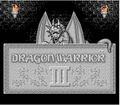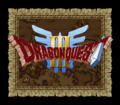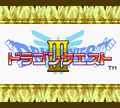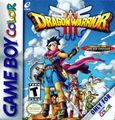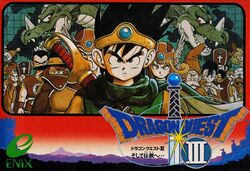
| Dragon Warrior III | |
|---|---|
| Developer(s) | Chunsoft |
| Publisher(s) | Enix, Nintendo |
| Year released | 1988 |
| System(s) | NES |
| Preceded by | Dragon Warrior II |
| Followed by | Dragon Warrior IV |
| Series | Dragon Quest |
| Japanese title | ドラゴンクエストIII そして伝説へ… |
|---|---|
| Genre(s) | RPG |
| Players | 1 |
| Modes | Single player |
| Dragon Quest III: Soshite Densetsu e… | |
|---|---|
| Developer(s) | Heartbeat, ArtePiazza |
| Publisher(s) | Enix |
| Year released | 1996 |
| System(s) | SNES |
| Dragon Warrior III | |
|---|---|
| Developer(s) | TOSE |
| Publisher(s) | Enix |
| Year released | 2000 |
| System(s) | Game Boy Color |
| Rating(s) | |
| Dragon Quest III: The Seeds of Salvation | |
|---|---|
| Developer(s) | Matrix Software |
| Publisher(s) | Square Enix |
| Year released | 2014 |
| System(s) | iOS, Android, Nintendo 3DS, PlayStation 4, Nintendo Switch |
| Rating(s) | |
Dragon Quest III Soshite Densetsu e… (ドラゴンクエストIII そして伝説へ…? lit. Dragon Quest III: And thus into Legend…) was localized outside Japan as Dragon Warrior III. It's a role-playing video game developed by Chunsoft and published by Enix (now Square Enix). It is the third installment in the Dragon Quest series (known as Dragon Warrior in North America at the time of its original release), first released for the Famicom in Japan, and then the NES in North America. The game later was ported as an enhanced remake on the Super Nintendo in late 1996 and then on the Game Boy Color in 2001.
This is the final game in the Erdrick trilogy and is the first chronologically. The story follows the traditional Dragon Quest Hero, who is on an adventure to save the world from evil. Putting together a party of assorted classes, the Hero must travel the world, stopping at various towns and other locations, eventually making his or her way to the Demon Lord Baramos's lair.
While the combat system remains close to the previous Dragon Quest games, keeping battles turn-based and in first-person, Dragon Warrior III expanded on the open world and nonlinear gameplay of its predecessors, and introduced innovations such as a persistent world with its own day-night cycle, and a class-changing system inspired by Wizardry, which is later seen in Dragon Quest VI, Dragon Warrior VII, and Dragon Quest IX. This class system allows the player to customize his or her party by changing character classes during the game, and keep a character's stats and skills learned from previous classes. Dragon Quest III's class-changing system influenced future Japanese RPGs, especially the Final Fantasy series.
Story[edit]
Dragon Warrior III follows the adventures of the son (or daughter) of Ortega, a valiant warrior who fell trying to defeat the Archfiend, Baramos. On the hero's sixteenth birthday, the King of Aliahan sends you out on a journey to finish what your father started. The hero and his three companions will travel across, over, and under the entire world, save two lands from evil, and become legends.
Gallery[edit]
- Game title
NOTE: the original Japanese NES title screen is just Dragon Quest III in white letters on a black screen.
-
Localized NES title
-
SNES title
-
GBC original title
-
GBC localized title
- Game box
-
Localized NES box
-
Original Super Famicom box
-
Original GBC box
-
Localized GBC box
Versions[edit]
Note that the original title is Dragon Quest III: And thus into Legend... (literal translation from Japanese).
| Year | System | Notes |
|---|---|---|
| 1988 | NES | Localized as Dragon Warrior III. |
| 1996 | SNES | Japan only; it includes an extra dungeon (Sky World), the Small Medals sub-quest and five Pachisi Tracks. |
| 2000 | GBC | Localized as Dragon Warrior III; it includes another extra dungeon (Ice Cave). |
| 2009 | Phones | Japan only. |
| 2011 | Wii | Japan only; part of Dragon Quest 25th Anniversary Collection. |
| 2014 | Phones | Localized as Dragon Quest III: The Seeds of Salvation. |
| 2017 | PS4/Nintendo 3DS | Japan only. |
| 2019 | Nintendo Switch | Localized as Dragon Quest III: The Seeds of Salvation. |
Table of Contents
- Enemies
- Experience chart
- Pachisi Track (GBC/SNES)
- Small/Tiny Medals (Remakes)
- Monster Medals (GBC)
- Versions

